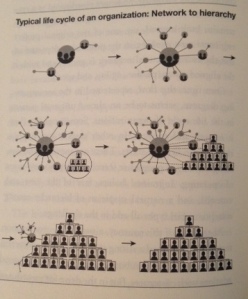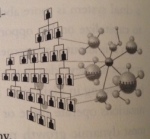 I presented my synopsis of Accelerate yesterday at the First Friday Book Synopsis. (Accelerate (XLR8): Building Strategic Ability for a Faster-Moving World by John Kotter
. Harvard Business Review Press, 2014). Here is a brief summary of what John Kotter says in his new book, Accelerate:
I presented my synopsis of Accelerate yesterday at the First Friday Book Synopsis. (Accelerate (XLR8): Building Strategic Ability for a Faster-Moving World by John Kotter
. Harvard Business Review Press, 2014). Here is a brief summary of what John Kotter says in his new book, Accelerate:
Whatever is working well now is threatened now.
The pace of threats coming at you is accelerating.
Thus, the ability to change needs to accelerate.
The only solution to this problem – and it is a big, serious problem – is a dual operating system.
A “traditional” hierarchical system to make the “trains run on time.” (That’s the description of Ron Holifield, CEO of Strategic Government Resources).;
And a “network system” that is alongside the hierarchical system, whose job it is to stay ahead of the accelerating curve.
These two systems have to be genuinely dual – that is, the networking system has to be fully embraced by everyone, applauded for its work, and listened to and followed by all as if it were fully “equal” to the hierarchical system. Because, in reality, it is equal.
The people who populate this network system have to be from within, intrinsically motivated, and have to include at least 5-10% of the entire organization.
This is a truly new approach to organizational structure (from the book: although the dual system is a new idea, it is a manner of operating that has been hiding in plain sight for years). And, it is now a business survival necessity.
Mr. Kotter has really useful insight into corporate lifecycles. I kind of put it into my own words, and shared this in my presentation:

• A brief look at “Corporate Lifecycles” (with RM’s re-wording)
- Stage 1 — Networks (no Hierarchies)
- Stage 2 – Networks, some Hierarchies
- Stage 3 — Networks and Hierarchies (to, Hierarchies and Networks)
- Stage 4 – Hierarchies, some Networks
- Stage 5 — Hierarchies (no Networks)
- (and then, I added a Stage 6 verbally – “Goodbye”)
The book presents five principles driving the Dual Operating System, and then Eight Accelerators:
The Five Principles driving the Dual Operating System:
Principle 1 – Many people driving important change, and from everywhere, not just the usual few appointees.
Principle 2 – A “get-to” mindset, not a “have-to” one.
Principle 3 – Action that is head and heart driven, not just head driven. (RM – Aristotle; logos & pathos). (You must also appeal to how people feel).
Principle 4 – Much more leadership, not just more management.
Principle 5 – An inseparable partnership between the hierarchy and the network, not just an enhanced hierarchy.
• The Eight Accelerators
- Accelerator 1: Urgency Aligned Around A Big Opportunity
- Accelerator 2: The Guiding Coalition
- Accelerator 3: A Change Vision And Strategic Initiatives
- Accelerators 4 & 5: Attracting Volunteers, Driving Initiatives
- Accelerators 6–8: Wins, Wins, And More Wins
And, here are my takeaways from the book:
1. Morale matters – and hope matters. The Dual Operating System can build both.
2. Good execution – of yesterday’s strategy – is no longer enough!
3. Strategic planning has to be done more often; with more flexibility to change. The world is moving too fast for the old corporate calendar of strategic planning sessions.
4. From within seems to work better than from without (“consultant written” statements and plans).
5. In a world of accelerating change, organizations simply must make organizational structure changes. It is truly “change, or die” time. This Dual Operating System, or something like it, needs to be embraced, and implemented…now!
Here’s a description of this dual operating system:
The basic structure is self-explanatory: hierarchy on one side and network on the other. The network side mimics successful enterprises in their entrepreneurial phase, before there were organization charts showing reporting relationships, before there were formal job descriptions and status levels. That structure looks roughly like a constantly evolving solar system.…
seamlessly connected to and coordinated with the hierarchy in a number of ways, chiefly through the people who populate both systems
Here’s what I think. We keep reading that the world is changing. And, as it does, the organizations of yesterday will not be able to compete today and tomorrow without serious changes themselves. This book helped me grasp the why of this a little more clearly. The very word, “accelerate” (“acceleration”) explains the why. We don’t have very long to make the changes we need to make. And then, the next change will have to be made even faster, and then…
{See also this earlier blog post, So, Why Do People Actually Resist All Attempts at Change? – John Kotter Provides a Clue, and notice especially this line:
In other words, it may cost more to not change than it does to change.}
So, whether you embrace Mr. Kotter’s solution, or come up with your own, you’d/we’d best do something – something dramatic. Or else!
——————–
 My synopsis of Accelerate (along with synopses of many other books from the First Friday Book Synopsis), with the audio recording of our presentations, and our multi-page, comprehensive handouts, are available from our companion site, 15minutebusinessbooks.com. (Acclerate will be up on the site in a couple of weeks, or so).
My synopsis of Accelerate (along with synopses of many other books from the First Friday Book Synopsis), with the audio recording of our presentations, and our multi-page, comprehensive handouts, are available from our companion site, 15minutebusinessbooks.com. (Acclerate will be up on the site in a couple of weeks, or so).

